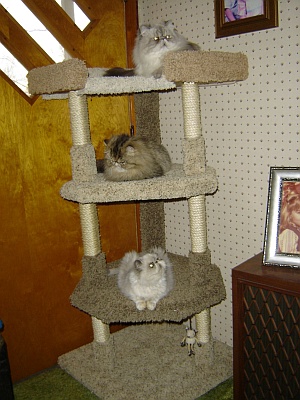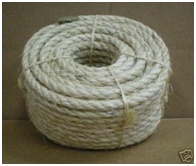

Veterinarians: |
| I suggest you choose a vet close to you that is approved by the American Association of Feline Practitioners here is a link to their Find a Feline Practitioner. Your kitty will have shots and worming to last until she is one year old. At that time you will take her in for annual booster and take along a fresh stool sample for a fecal exam. However, is good to choose a vet now “just in case” you need one sooner. |
I am totally against declawing cats/kittens.It is a surgical procedure that actually amputates the first digit of each toe! Would YOU appreciate having the end of every finger and toe cut off? As long as you have a scratching post (see below) and trim his nails each week you will have no problems |
| Your kitty should NEVER go outside thus you never need to get the Feline Leukemia (FeLeuk) vaccination. Once given your kitty would always test positive for FeLeuk and you would never know if she really has it. |
Scratching Post: |
| This is a Cat tree I made myself from 2 x 4’s and 5/8” thick flakeboard, a staple gun and scrap carpeting |  |
They are EASY to make yourself! 3/8” Sisal rope at Lowes or Home Depot |  |
|
Colbetz kitties are used to Sisal rope type and carpet type scratching post/trees. Here are images of some cat trees from google. They also have them for sale at many of the CFA Cat Shows for cash and carry, and you save on shipping! Be sure it is well made and heavy duty as your kitty will be a large cat when full grown. |
Grooming: |
1. Buttercomb This comb will last a lifetime. Christensen grooming products are the best. This supplier has free shipping. An alternative is: any 7.5 inch long stainless steel comb with fine/coarse teeth that are 1 inch long or longer. 2. Small 4.5” face comb: http://groomerspro.com/FaceButtercombbyChrisChristensen.aspx 3. Oval Cat Pin Brush (for when her coat is full and long) there should be no “balls” on the tips of the pins to get tangled in the long hair breeds 4. Cat toenail clippers (clip nails once a week) this type are the best because the extra finger rest enables you much better control: http://www.amazon.com/BRAND-PROFESSIONAL-SCISSORS-grooming-Clippers/dp/B00495Q9MA I think I got mine at Petsmart. 5. Remember no collars or flea collars. They will tangle the coat to a solid mess around the neck. The vet sells excellent topical flea applications, if you feel you need one. Revolution is the best. 6. Eye Care: the hair around the eyes must be washed each day to prevent the tearing from burning the skin and start eye infections. You will need “Sterile Saline Water” cost about $4, and round cotton pads. Both can be found at any pharmacy. http://www.drugstore.com/walgreens-saline-solution/qxp494742?catid=328036
http://www.drugstore.com/swisspers-multi-care-cotton-rounds/qxp209215?catid=180640 (cotton pads) To treat any red staining from the tears I use Eye Envy. It is a two step liquid and then powder application: Eye Envy Starter Pack After getting the exterior eye area clean, put one drop of Refresh Liquigel in each eye. http://www.drugstore.com/refresh-liquigel-lubricant-eye-drops-2-bottles/qxp77217?catid=184393 (lubricating eye drops) 7. Ear Care. I use VetWELL Ear Cleaner for Dogs and Cats - Otic Rinse, filling up the ear with the water-like cleaner and then massaging the ear canal (located under the ear and down towards the jaw). You want to loosen the wax from deep down in the ear canal. You will also rub it around with your thumb on the inside of the ear. This product actually dissolves the oily ear wax from in the ear. The cat will shake it’s head and the solution will fly out along with the loosened wax. Looking down into the ear if you see dirty areas you can wet a q-tip with the ear cleaner to get into those small crevasses. Use the “child safe” q-tips to avoid accidental puncture of ear drum from too deep a penetration with the swab. 8. Treats. It is essential to give your kitty a treat as a reward after any grooming procedure. They look forward to getting their treats and it is a special bonding moment between you and your pet after grooming sessions. |
Bathing: |
|
All Colbetz kittens
are used to being
bathed once a week. This removes dead
hair/shedding and stimulates her skin and coat to be healthy and
therefore she will shed/tangle less as well. Be sure to have her
TOTALLY combed out before you begin. |
Food: |
|
1. All cats here at Colbetz are on a Raw Diet available from Darwin's Pet and fed at least twice daily They always have
free access to
Solid
Gold Let's Stay In Chicken, Lentil n Apple Recipe Adult
Grain-Free Indoor Dry Cat Food.
|
Litter: |
|
My kittens are used
a The Arm n Hammer large sifting litter box for cat pan and
"Tractor Supply Pelletized Bedding" for the litter.
I buy the 40 lb. bags at for only $7 at Tractor Supply. Never use clay litter or clay clumping litter! |
Cat Carrier: |
|
Be sure to bring along a carrier to take your new kitten home. It is VERY dangerous to hold a kitten in your lap while traveling. They can easily become over stimulated from the passing cars and trucks and try to make every effort to escape before you can get her under control and cause a car accident. You will need a carrier anyway to take her to the vet for future shots and/or boosters shots. I like this soft canvas one it folds up when not being used. If you go to WalMart and purchase the same item as in the link, get the one that measures: (20"L x 13"W x 13"H) plenty roomy enough for a full grown Himalayan. Don’t get a tiny kitten carrier. Himalayan cats are medium to large cats and my kittens will weigh about 8-10 lbs. when full grown. |
Introducing your new kitty to your home: |
|
Cats need to become thoroughly familiar with new surroundings before they feel comfortable. An entire apartment or house can be overwhelming all at once. Many cats will hide under beds or furniture, sometimes for days. It will be much less stressful for your cat to learn about you, your family and her new home a little at a time. This is even more important if there are multiple people and/or pets in your household. When you bring your cat home, place her in the room you have fixed up for her, keep this room closed off, and let her explore that area first. Let the kitten come out of her crate on her own; do not try to coax her or tip the crate to force her out. Cats are curious and most will soon come out to explore their surroundings. If the kitten seems very timid, you can leave the room for a while and check back later. If you really want to stay in the room, get a book and read. When the cat is ready to come out, stay where you are and let her come to you. Talk in a soft, reassuring tone, pet her if she seems interested, but do not try to pick her up. Leave the open carrier in the room so that she has a safe retreat if she wants one. Give her time to learn that she can trust you. Introduce other family members slowly. Have them come into the room one at a time to pet and play with the cat. Have younger children sit down, show them how to gently stroke the cat's fur saying “head to tail” while doing so and offer her a few treats. Make certain that children understand that they are not to chase the cat, hurt her or bother her while she eats, sleeps, or uses the litter box. If there are no other pets, you can let the cat begin to explore the rest of the house in a few days. |
This page last modified: